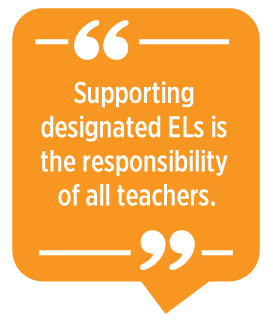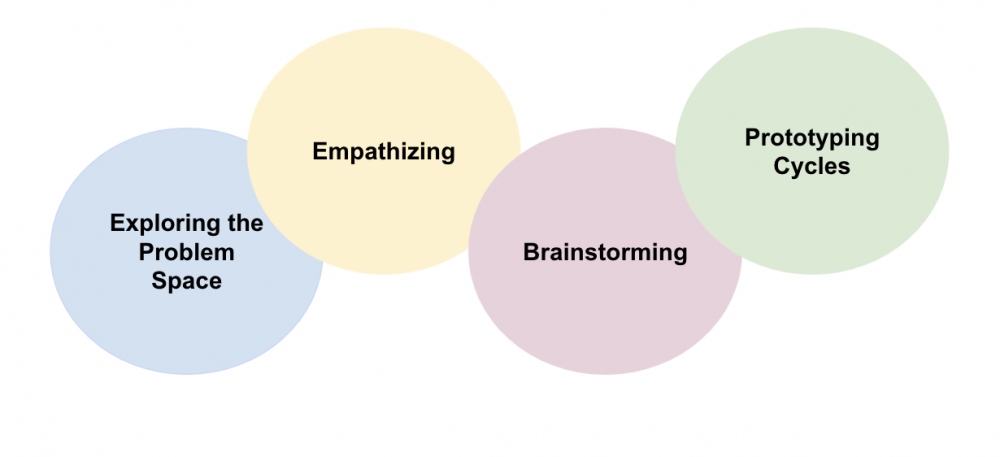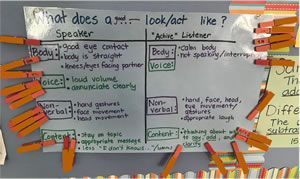Designing a Whole-Class Approach to Supporting ELs
by Kimiko E. Lange, Rose K. Pozos, Annie Camey Kuo, Melissa Mesinas, and Shelley Goldman

Meet
Kristen,* a third-grade teacher with a small but increasing number of students
designated as English learners (DELs) in her classes each year. Despite more
than 10 years of classroom experience, she felt underprepared for and a little
overwhelmed by the task of supporting English language development for her
DELs. Sound familiar?
Supporting
DELs is the responsibility of all teachers, whether a 30-year veteran English
as a second language (ESL) specialist or a mainstream teacher with a single DEL
in their class this year. Readers may already be familiar with TESOL’s “6 Principles for
Exemplary Teaching of English Learners” (TESOL International
Association, 2018) as a guide to doing this. Certainly, it is hard to argue with
the value of principles such as “P1. Know your learners,” “P2. Create
conditions for language learning,” or “P6. Engage and collaborate within a
community of practice.” But how might one go about enacting these principles?
Read on to see an example of how Kristen, with a little help from an
unconventional teacher professional learning model, developed a strategy that
focused on DELs but ultimately supported her whole class.
A Fresh Take on Teacher
Professional Learning
Our project,
known as English Learners and Design Thinking (ELDT), began in 2017 (Goldman et
al., 2020). ELDT is part of a long-term research-practice partnership (Coburn
& Penuel, 2016) between university researchers and surrounding schools.
We work with 15 primary schools in five surrounding school districts to address
a mutually identified problem of practice: raising awareness of and support for
the needs of DEL students among teachers and administrators, and creating
curricular and systemic changes for their benefit.
 As we
deepened our engagement with this work, we came to use the abbreviation “DEL”
in lieu of the more common “EL.” This serves as a reminder that the latter is
merely a designation—a label placed upon students by our school systems that so
often implies that these students are somehow not up to the task of learning,
instead of highlighting their rich cultural, linguistic, academic, social, and
experiential assets.
As we
deepened our engagement with this work, we came to use the abbreviation “DEL”
in lieu of the more common “EL.” This serves as a reminder that the latter is
merely a designation—a label placed upon students by our school systems that so
often implies that these students are somehow not up to the task of learning,
instead of highlighting their rich cultural, linguistic, academic, social, and
experiential assets.
To support
teachers and administrators attend to their DELs’ potential, we use a
combination of design thinking (Goldman & Kabayadondo, 2016) and hybrid
workshops (Rutherford-Quach et al., 2018) as a new take on professional
learning.
Design
Thinking
Design
thinking is a set of mindsets and practices that relies on an empathy process
to support active teacher learning and engagement. The process is flexible (see
Figure 1), with the teacher cycling through iterations of discovering their
user’s needs (in this case, their DEL student), figuring out what issues are
presenting challenges for them, and intentionally engaging their own empathy to
draw out fresh insights to inform design solutions.

Figure 1. The Design thinking process: A method for
solving complex problems. (Used with permission from Shelley Goldman, Stanford
University; click here to enlarge.)
In ELDT,
teachers apply design thinking by starting each year with an empathy project.
They select a DEL “focal student” in their class for whom to design, then
gather data about them through methods such as observations, surveys, and
interviews. They analyze what they’ve gathered to figure out the challenges,
needs, and resources of their student, then brainstorm and prototype ideas for
possible interventions. Over many months, teachers try out their interventions
and iterate on them, learning from failures and feedback to design subsequent
iterations and track their effectiveness through each.
Hybrid
Workshops
Hybrid
workshops support teachers’ designing process by offering timely research on
DEL topics, which the teachers bring to the forefront in the learning
prototypes they create for their students. Content and resources are cocreated
by members of the research-practice partnership to be as relevant as possible
to the DELs’ specific contexts. Workshops occur both virtually and in-person
throughout the year, facilitating not only the development of knowledge and
strategies, but simultaneously engaging teachers in the empathy-driven design
thinking process through discussion, reflection, and application.
Examples of
workshop topics include
-
“Social Emotional
Well-Being” (developing a line of communication between teachers and DELs’
families)
-
“Dually Identified
Students” (supporting DELs who are also receiving SPED services
-
“Constructive Classroom
Conversations” (facilitating student-to-student conversations and enhancing
pair-share activities)
Several
teachers in our project found the workshop on “Constructive Classroom
Conversations” (based on materials developed by Understanding
Language) particularly helpful as an integrated approach they could
take to enhance language support for DELs in their classrooms. We illustrate
one such case with Kristen’s story.
Kristen’s Design: From
One to Many
Recall
Kristen, a veteran teacher who wanted to improve her instruction for DELs in
her third-grade classroom. She joined the project alongside two fellow teachers
and her principal.
Kristen
began her design thinking cycle at the start of the school year with her
empathy building activity: observing her focal DEL student, Sonia. Initially,
she noted that Sonia was “very quiet.” “I just didn’t see her bonding with
friends,” she observed. Through this activity, Kristen realized she needed to
take time to learn what Sonia was experiencing in the classroom. She would need
to set up her classroom in a way that would help Sonia feel more comfortable
talking.
Following
the design thinking cycle, Kristen conducted further observations. This time,
she noticed that Sonia was
involved in
listening, reading to herself and writing her group’s main idea sentence in her
Reader’s Workshop journal.…She talked once, but so quietly, I don’t think
others heard. [However,] she was fully engaged in the activity as an active
listener and recorder.
These
observations launched Kristen’s prototyping phase of design thinking. Inspired
by the “Constructive Classroom Conversations” hybrid workshop, Kristen teamed
up with two colleagues to redesign their daily morning meeting routines, to
incorporate a way for their students to learn about elements of conversation.
Three times a week, student pairs conversed on nonacademic topics by using
sentence starters. In her class, Kristen set Sonia up in a purposeful
partnership with a classmate to help create a social bond, which played a
crucial piece in leveling the languaging playing field.

At first,
Kristen couldn’t hear what Sonia was saying, which made it difficult to
determine her progress. So she iterated and codeveloped a skills poster with
her colleagues (Figure 2). The poster outlined how a “good speaker” and an
“active listener” might look, sound, and behave. Each student would choose a
conversational skill to work on that day, and place a clothespin with their
name next to it. At the close of their morning meeting, their conversation
partner would provide feedback on how they met their goal. With this one
change, Kristen expanded her support for conversational skills from being
focused on Sonia to meeting a whole-class need.
Kristen
shared that the poster was empowering for students, including but not limited
to DELs. It provided structure, in the form of a visual, but also in its
predictability (when they’ll practice what) and social motivation (partners).
Every student worked on their respective goals over extended periods of time,
in a way that held them accountable to one another. Soon, Kristen was able to
hear Sonia speak and stay on topic. As Sonia continued to make progress,
Kristen continued to build on her social conversations by integrating these
speaking skills with academic activities. In the next school year, Kristen and
her colleagues rejoined our ELDT project in order to continue refining their
model.

Figure 2. Kristen’s conversation board. (Click here to enlarge.)
Characteristics
of Success
What made
Kristen’s design so successful? Certainly a combination of factors, but three
characteristics of Kristen’s case stood out across the educators who seemed to
have the most success with their prototypes and reported transformative results
engaging their DELs.
Embracing
Empathy
First, these
educators embraced empathy. Observing students may have already been part of
their practice before ELDT, but embracing empathy was what really helped them
gain more information and new insights about their students. Teachers who
embrace the empathy process develop a heightened focus on the social nature of
language acquisition and positive or more nuanced perceptions of DELs. Like
Kristen and Sonia, teachers observed their DELs become more engaged and
comfortable communicating. They also expressed understanding of the importance
of creating a welcoming classroom environment for DELs.
Failing
Forward
With the
information they collected and new insights they gained, the teachers were able
to try different innovations, adjusting them as they saw what worked and what
didn’t. This embodies the second design thinking characteristic we noticed:
failing forward. Kristen, her colleagues, and other educators in our project
constantly iterated on their designs, seeking and incorporating students’
feedback along the way instead of giving up. They used information from their
so-called “failures” to design better iterations for their students each time.
Finding
Partners
Finally,
finding partners in designing innovations frequently led to more success. We
like to think that Kristen not only found her fellow teachers as partners, but
enlisted her students as well, taking a whole-class approach to supporting
DELs—and benefiting all students in the process.
Conclusion
We offer our
project as an example of how educators can improve their support of students
designated as English learners using design thinking. From Kristen’s example,
we saw how insights about one student’s experience can provide inspiration for
whole class instruction. However, the key to supporting DELs does not lie in
any singular design; what is more important is the mindset of the teacher and
their willingness to observe carefully, embrace empathy, fail forward, and find
partners in their work. This can yield fresh insights that lead to more
effective supports for language development.
*NOTE: All
participants’ names are pseudonyms.
References
Coburn, C.
E., & Penuel, W. R. (2016). Research–practice partnerships in
education: Outcomes, dynamics, and open questions. Educational Researcher,
45(1), 48–54.
Goldman, S.,
& Kabayadondo, Z. (Eds.). (2016). Taking design thinking to
school: How the technology of design can transform teachers, learners, and
classrooms. Routledge.
Goldman, S.,
Kuo, A. C., Pozos, R. K., Mesinas, M., & Lange, K. E. (2020).
Empowering teachers through design thinking. RChD: creación y
pensamiento, 5(8), 37–48.
https://doi.org/10.5354/0719-837x.2020.55992
Rutherford-Quach, S., Kuo, A. C.,
& Hsieh, H. (2018). Understanding their language: Online professional
development for teachers of ELLs. American Educator,
42(3), 27.
TESOL International Association.
(2018). The 6 principles for exemplary teaching of English learners:
Grades K–12.
Kimiko E.
Lange taught ESOL and Japanese for 8 years before
beginning her PhD at the Stanford Graduate School of Education. Her research
and activities focus on multilingual teachers, teacher education, and how
teachers share authority with students through language. Creativity and careful
observation are design thinking features she hopes to cherish in her own work
and with others.
Rose K.
Pozos is a PhD candidate in the Learning Sciences and
Technology Design program at Stanford University. She studies design thinking
to support curriculum design, linguistically equitable computer science
education, and home-based learning during the COVID-19 pandemic.
Annie Camey
Kuo is the director of research-practice partnerships
for Understanding Language – Center to Support Excellence in Teaching at
Stanford University. Her work focuses on building systems of support for
multilingual students with schools, states, and organizations. Before coming to
Stanford, Annie worked with teachers and international school leaders in
supporting culturally and linguistically diverse students at the University of
Washington. Her areas of interest include design thinking, project-based
language learning, and multilingual learners.
Melissa
Mesinas is a consortium for faculty diversity
postdoctoral fellow and visiting assistant professor at Scripps College. Her
research focuses on the development and learning process of youth within the
contexts of Indigenous diasporic learning communities, and design thinking to
support multilingual students.
Shelley
Goldman is a professor at the Stanford Graduate School
of Education. She is a former elementary and middle school teacher and helped
to start three public schools. She works with teachers and administrators on
using design thinking to create truly meaningful and transformative learning
experiences for K–12 students.